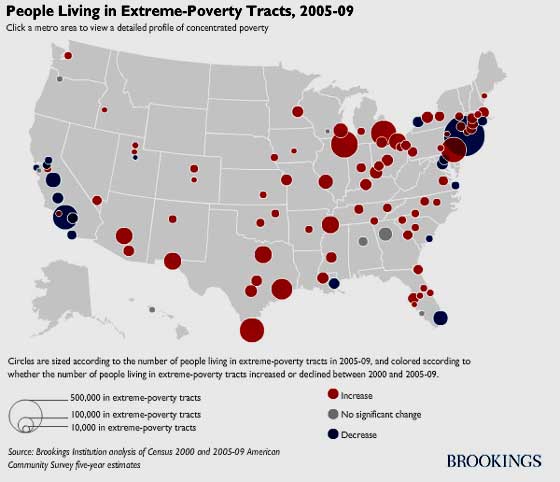There are two studies which show bad news for Americans. The first is one by the Brookings Institute, The Re-Emergence of Concentrated Poverty: Metropolitan Trends in the 2000s, which shows extreme poverty has dramatically increased and has become concentrated.

The study uses the beyond belief not realistic government poverty levels. For one person, the poverty threshold is $10,830 and for a family of 4, it's $22,050. Pew analyzed the Census American Community survey and found some more depressing statistics for America.
Over a ten-year span, the country saw the poor population grow by 12.3 million, driving the total number of Americans in poverty to a historic high of 46.2 million. By the end of the decade, over 15 percent of the nation’s population lived below the federal poverty line—$22,314 for a family of four in 2010—though these increases did not occur evenly throughout the country.
If you want to know why NAFTA generates frothing at the mouth in the rust belt, just look at these poverty results from areas hardest hit by NAFTA and the China PNTR trade treaties. Both of these treaties resulted in hundreds of thousands of manufacturing jobs moved offshore.
Concentrated poverty nearly doubled in Midwestern metro areas from 2000 to 2005–09, and rose by one-third in Southern metro areas. The Great Lakes metro areas of Toledo, Youngstown, Detroit, and Dayton ranked among those experiencing the largest increases in concentrated poverty rates, while the South was home to metro areas posting both some of the largest increases (El Paso, Baton Rouge, and Jackson).
And here's the kicker, more college educated and white people are falling into extreme poverty. Notice offshore outsourcing, which hit occupations dominated by white people, started in earnest, about 2000.
Compared to 2000, residents of extreme-poverty neighborhoods in 2005–09 were more likely to be white, native-born, high school or college graduates, homeowners, and not receiving public assistance. However, black residents continued to comprise the largest share of the population in these neighborhoods (45 percent), and over two-thirds of residents had a high school diploma or less.
We also are getting the poor moved into glorified ghettos again:
After declining in the 1990s, the population in extreme-poverty neighborhoods—where at least 40 percent of individuals live below the poverty line—rose by one-third from 2000 to 2005–09. By the end of the period, 10.5 percent of poor people nationwide lived in such neighborhoods, up from 9.1 percent in 2000, but still well below the 14.1 percent rate in 1990.
The Brookings study is fairly thorough with a full multimedia presentation.
In the second study, Pew Charitable Trusts graphed up and tabulated BLS data on the long term unemployed by industry, age and education level. If this isn't evidence of institutionalized age discrimination in America, I don't know what is. People over 55 are disproportionately not finding new jobs.
In the third quarter of 2011, more than 43 percent of unemployed workers older than 55 had been out of work for at least a year.

Don't think education will save you either. Check out the even distribution by education level for those unemployed over a year:
In the third quarter of 2011, 34 percent of unemployed workers with a bachelor’s degree had been without work for a year or longer, compared to nearly 38 percent of jobless high school graduates and approximately 39 percent of unemployed people who have not completed high school.
The Pew addendum adds to the duration of unemployment figures usually reported by the BLS.
In the third quarter of 2011 approximately 31.8 percent of the nearly 14 million Americans who were unemployed had been jobless for a year.
Together these two studies show once again, the U.S. worker is getting squeezed in every direction. Until politicians start putting the U.S. worker first and foremost in policy considerations, it doesn't look like things will get better anytime soon. Both of these reports point to disaster in the future as well. Extreme poverty breeds crime, desperation, despair and economic atrophy. People who need work who are nearing the retirement age will be absolutely destitute later with nothing to live on and no more ability to work due to failing health.
In other words, these two reports point to a future socioeconomic hurricane coming our way.

Comments
Attack on Brookings Study
As you may be aware, the crtique of the study tries to count all the extra non-cash welfare benefits such AFDC, Medicaid, Unemployment Insurance, rent subsidies and SDI to suggest that the $22K figure is grossed up quite a bit. The reality is that the unbelievably low $22K allowed for the gross-up of benefits. No family can really live on $22K, so benefits needed to be included.
A more relevant policical point is that so many of those willing to point to the safety net are the very first to want to take the safety net away. I will locate the critique, if that is the right term.
Burton Leed
extreme poverty & Census
I just did a brief overview of the Census report, located here.
You can compare the two poverty measures, but by either one, including EITC, Food stamps and so on, or not, both of them show poverty at all time highs.
So, I don't see how they can attack Brookings or the Census by including subsidies and so on, for what the alternative measure shows is even with the meager social safety nets in the U.S., even more people are actually living in poverty.
I think some leftist groups jumped the gun before the actual data is released or something because looking at both, they both show 1 in 6 basically is living in poverty here.
Also, there might be some confusion because the official poverty thresholds used by Brookings are well defined. What Brookings means by extreme poverty is 40% of the local population is living below the poverty line.